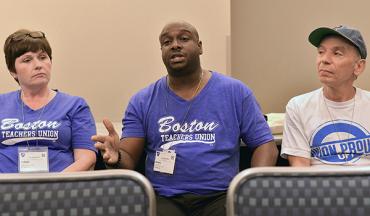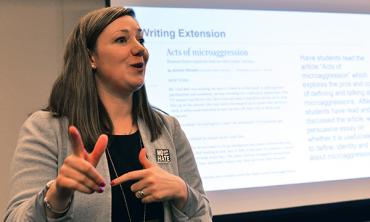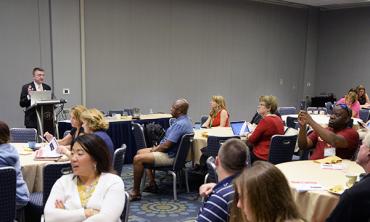Educators must be guardians of our democratic principles such as human dignity, equal rights, tolerance of diversity, civility and the rule of law, AFT President Randi Weingarten said during her keynote address at AFT TEACH on July 11: “The fight to safeguard American democracy begins in our classrooms and our schools. And TEACH is chock-full of how-to sessions.”
One such session, “Current Events Classroom—Teaching About Bias, Diversity and Social Justice,” helped the educators who packed the room learn strategies to talk about current news topics like immigration and family separation, the #MeToo movement, pay inequality and other news events from multiple perspectives.
Talking about current events in the classroom is a great way to engage students while building on the skills they need to become educated and empowered citizens, said the session’s presenter Michelle Magner, assistant education director at the Anti-Defamation League.
The session began with a question. Where do we get our news? The answers ranged from television to podcasts. And while most adults get their news from a variety of sources, including television, social media, radio or newspapers, most 18- to 29-year-olds get their news from online sources such as Twitter or Facebook. But Magner warned that there is a danger in getting news from a single source.
“Thanks to the advent of social media and technology, [students] may be getting information from the same place, and that impacts their perception of things,” said Magner. “Using different news resources can combat media bias.”
Most educators use current events in their classroom; according to a survey from the Education Week Research Center, which Magner shared with attendees, some of the issues teachers said they are talking to their students about focus on race/ethnicity, immigration, national politics, gender roles, gun violence, LGBTQ issues, and cyberbullying.
Although the topics can be controversial, a majority of educators (55 percent) don’t shy away from the discussion, according to the same survey. That means the other 45 percent do avoid such discussion, Magner noted.
One reason for this avoidance is the fine line between what educators can discuss and the support they get from their administrators, said many of the teachers in the session.
“Usually I talk about the facts of an event, but sometimes we have to pause and talk about life,” said Andrea Dockery-Murray, a member of the Cleveland Teachers Union.
“Guiding students in a neutral space will help,” said Magner. “However, there are times when an educator has to challenge some things” that are said in their classrooms to make their space feel safe. “Saying nothing isn’t being neutral. When you are silent, it reinforces an idea.”
Educators who want to include current events in their curriculum should start by thinking about the physical and emotional climate of their classroom, said Magner. She also suggests educators make the discussion interactive. “Let students talk to each other, and have them do research and investigation to ensure multiple perspectives.”
The ADL offers resources and articles on initiating conversations about current events.
In the session “Interactive Constitution: Civic Education for 21st-Century Learners,” Tim Rodman, a high school social studies teacher in Montgomery County, Md., showed a roomful of middle and high school teachers the wide array of teaching tools available from the National Constitution Center in Philadelphia.
Students often ask him: What do you believe? Rodman says this misses the point, which is to ask not what the government should do but what the government can do under the Constitution. The idea, he said, is to “think like a constitutional scholar.”
On Sept. 17, which is Constitution Day, the center will roll out a new classroom tool that’s mobile-friendly. The Interactive Constitution constitutioncenter.org/interactive-constitution compares U.S. citizens’ rights with people’s rights around the world. The goal is to get students to start talking to each other about their interpretations of the Constitution. Teachers can start the conversation and continue it on social media, including Edmodo, Poll Everywhere or Flipgrid. The center’s most recent component is Classroom Exchange, rolled out last September, in which teachers link their classrooms via Skype or Zoom for discussion.
Rodman showed a video in which U.S. Supreme Court Justice Stephen Breyer explains how justices make decisions: first, in writing, through legal briefs; then in oral arguments; then in discussions and through listening. Breyer exhorts Americans to see that “It isn’t just a question of who has the best argument. It’s a question of listening to each other.” Next, each justice writes an opinion. Arguments don’t have to be contentious, Breyer says. If you stay calm and listen, “You would be surprised at how often you can work things out.”
As opposed to teachers who want students to put their phones away, Rodman wants kids to use phones “for good, not evil.” He suggests hosting a Classroom Exchange, with an attorney, judge or legal advocate working with the National Constitution Center to moderate the session.
The center offers lesson plans, a newsletter specifically for educators, plus workshops, Saturday teacher seminars, town hall programs, online lesson plans, videos and other resources. Aside from the website at constitutioncenter.org/interactive-constitution, you can email education@constitutioncenter.org or call 215-409-6600. The center soon will be rolling out a Constitutional Ambassadors program as well. To learn more, contact exchange@constitutioncenter.org.
[Adrienne Coles and Annette Licitra/Miisha Nash photos]



